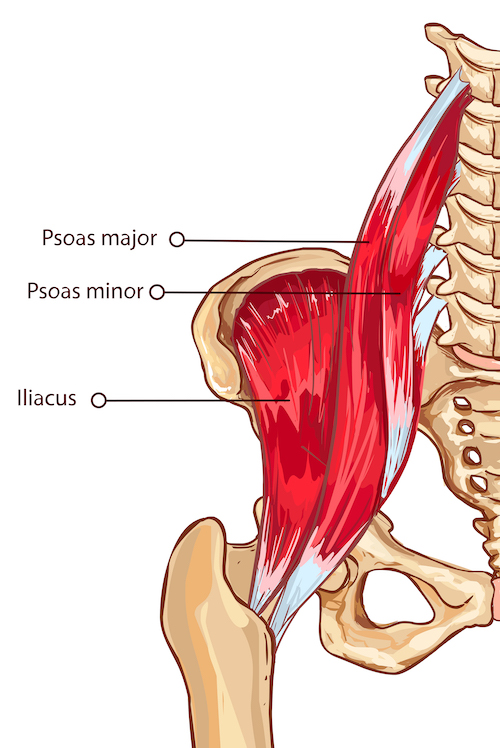Many people struggle to sit on the floor. In this post, I’ll look at the anatomy of the hips and lower back to see why that might be, then cover a few tips for how to sit comfortably on the floor.
The anatomy of sitting
To sit cross-legged, your hips have to flex, as well as externally rotate, so that the front of the thighs rotate away from the midline, and abduct, so that the thighs open out to the side.
At some point during hip flexion, the thighs will press against the front of the pelvis, rolling the pelvis backward into a posterior tilt. The deeper the fold at the hips, the more likely that is to happen. Hip flexion also stretches the muscles of the back of the hip, and the tension in those muscles will also tend to roll the pelvis backward.
Any movement of the pelvis will affect the lumbar spine, which is normally curved forward in what’s called a lordotic curve. That’s important for weight bearing support. The forward curvature of the lumbar spine centralizes the support underneath the structures it has to hold up: the rib cage, shoulder girdle and the head. If you lose the lumbar curve and it flattens out or rolls backward, you lose some of that support.
How comfortably you can sit cross legged depends on your range of motion in external rotation and abduction. If you lack that range of motion, your thighs will be drawn toward your chest, which will then roll the pelvis and lumbar spine backward.
As you start to fall backward, you may maintain your balance by bringing your head forward to keep your weight on top of the pelvis. But, on some level, your nervous system will still feel like you’re about to fall, making it a challenge to relax in the posture. To keep from falling even farther backwards, your hip flexors will contract.
What happens as your hip flexors contract?
The primary hip flexor is the iliopsoas, which consists of two muscles: the iliacus and the psoas major. The psoas major originates on the front of lumbar spine, passes across the front of the pelvis and attaches to the inner upper thigh bone, or femur, through a common tendon with the iliacus (which originates from the pelvis).

When the psoas major contracts, it pulls the femur toward the front of the spine, flexing the hip—or it pulls the lumbar spine toward the thigh. Either way, it creates hip flexion, which is what you need for sitting.
But if your thighs are not stable, contracting your psoas major to pull your lumbar spine forward will also lift your thighs, which will tend roll the pelvis backward again. When that happens, the cross-legged position becomes quite unstable. You’re fighting to keep yourself from falling backwards, but the more you do, the more the knees lift, pushing the pelvis backward again. Definitely not a relaxing position.
So what can you do?
The first thing to try is to elevate your hips by sitting on a folded blanket. This should go a long way toward making sitting more comfortable.
Why? Elevating the hips drops the thighs relative to the pelvis. You don’t need as much hip flexion to sit, so there will be less tendency for the thighs to roll the pelvis backward. The weight of the thighs will help to pull the pelvis forward, and you won’t have to work so hard with your psoas major to try to keep yourself upright.
If a blanket doesn’t create enough lift, you may need something thicker, like a yoga block or a bolster. However, it could also be that sitting cross legged isn’t the best position for you.
Everybody’s hips are different, and if your hips don’t allow for much external rotation, sitting cross legged may feel miserable no matter how much you elevate your hips. If that’s the case, you may want to forget about sitting cross legged and sit on your shins instead, so that your thighs are closer to parallel.
Try putting a block under your pelvis to sit on your shins for virasana, or hero’s pose. Straddling a bolster with your legs on either side may also work. These positions don’t require external rotation or abduction of the hips, so you may find they allow your thighs to drop down enough that your pelvis can roll forward effortlessly, making it much easier to support the weight of the upper body.
It’s worthwhile spending time experimenting with different ways of sitting to find what works best for you. However, for almost everybody, elevating the hips will probably help.
Finally, bear in mind that there’s no such thing as the perfect seated posture. In fact, oftentimes the best way of sitting is in a way that’s different from what you’re doing now. Sitting in any single position for a long time will probably become uncomfortable, so switch your position periodically.
Hi
To be honest your article is informative . I search many site to know about yoga but I didn’t get the information I needed.
I saw your site and I read it. I got some new information from here. It is beneficial for many more like me.
Thanks for share your kind information.
Thank you! I’m so glad my articles have been helpful for you